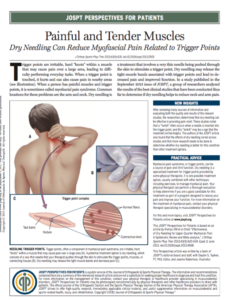How is dry needling integrated at Nashville Hip Institute at TOA?
After careful evaluation by your physical therapist, we may determine that dry needling could help improve your progress with pain, ROM, strength, and function. Dry needling is never the only treatment utilized, and is rather just one tool that our skilled practitioners may implement. No patient is forced to have this performed and all patients are informed of the risks and benefits associated with dry needling.
The musculature of and around the hip are commonly treated with the intention of either inhibition of overactive muscles or trigger points, or to facilitate muscles that may not be turning on properly. At times electrical stimulation is used along with dry needling to get the most benefit from the procedure.
What is dry needling?
“Dry needling is a skilled intervention that uses a thin filiform needle to penetrate the skin and stimulate underlying myofascial trigger points, muscular, and connective tissues for the management of neuromusculoskeletal pain and movement impairments. [It] is a technique used to treat dysfunctions in skeletal muscle, fascia, and connective tissue, and to diminish persistent peripheral nociceptive input, and reduce or restore impairments in body structure and function, leading to improved activity and participation.”
Source: APTA document Description of Dry Needling in Clinical Practice: An Educational Resource Paper. www.apta.org/StateIssues/DryNeedling/.
How is it different from acupuncture?
“Health care education and practice have developed in such a way that most professions today share some procedures, tools, or interventions with other regulated professions. It is unreasonable to expect a profession to have exclusive domain over an intervention, tool, or modality.”
“The practice of acupuncture by acupuncturists and the performance of dry needling by physical therapists differ in terms of historical, philosophical, indicative, and practical context. The performance of modern dry needling by physical therapists is based on western neuroanatomy and modern scientific study of the musculoskeletal and nervous system. Physical therapists who perform dry needling do not use traditional acupuncture theories or acupuncture terminology.”
Source: APTA document Physical Therapists & the Performance of Dry Needling: An Educational Resource Paper. www.apta.org/StateIssues/DryNeedling/.
Where can I find out more?
The “Dry Needling in Physical Therapy” page at www.apta.org/StateIssues/DryNeedling features resource papers describing what the intervention is, how it is used by PTs, APTA positions, evidence, and more. The site features state resources, as well, including attorneys general opinions
Location
2004 Hayes Street
Suite 700
Nashville, TN 37203
Office Hours
Monday-Friday:
8:00 am – 5:00 pm
